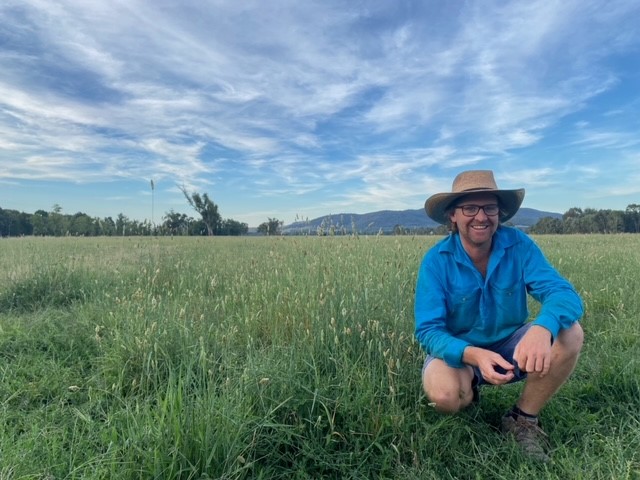Lime boosting pasture production

Tom Hicks in one of his phalaris pastures that’s benefited from phosphorus and lime
When Tom Hicks came back to the family’s composite stud and beef operation in the Riverina 11 years ago he was keen to look at ways of increasing farm productivity by lifting the performance of the business’ perennial pastures.
The key to unlocking the pasture’s potential has proven to be soil testing and involvement in the local Healthy Soils Group run by the Holbrook Landcare Group.
“If we can get the soil conditions right then we can really drive productivity,” Tom said.
“The economics of farming have changed dramatically in recent years with increases in commodity and land prices. It’s crucial to drive production on the land you manage.”
The Hicks family operation covers 3,640 hecatres across a range of soil types at Jingellic, Walwa and Holbrook where the annual rainfall is around 750mm. While not all the country is arable, the pasture is perennially based, with the phalaris the dominant pasture species.
The properties run 32,000 DSE of which Australian Beef Composite and Red Angus stud cattle make up of 20,000 DSE and the balance comprises commercial cattle.
Low hanging fruit
“I joined the Holbrook Landcare Group’s Healthy Soils group to help get an understanding of what we could do and identify what low hanging fruit we had in our soils which could help lift pasture productivity,” Tom said.
“We had a history of sporadic soil testing but hadn’t used it regularly.
“By regularly soil testing we can now identify what is holding our pasture production back and help set nutrient target levels.
“I looked at soil phosphorus (P) for a start because that was clearly holding production back at a Colwell P of 10–14 mg/kg and – depending on the paddock – and set a target Colwell P of 30 mg/kg.
“There was a visible response in pasture productivity with the increased rate of soil phosphorus.
“Once we had the target P levels in sight it was clear the next issue we needed to address was acidity which was the focus of the Healthy Soils Group.”
Soil testing showed while P levels were in the ideal range, soil pH (CaCl2) was around 4.5 and even lower at depth. Exchangeable aluminium levels in the top 10cm were up to 24%.
Working with agronomist Sandy Middleton and farm consultant John Francis, Tom looked at the recommended lime applications rates, the costs and the potential returns from increased pasture production and its impact on the feed budget and stocking rates.
The analysis showed that applying lime had the potential to increase the stocking rate by 25–35% and provide a positive return on investment.
Clear benefits
“The analysis stacked up, so we applied lime as quickly and as cheaply as possible to the surface of some established pastures – the first load went out about four years ago,” Tom said.
“We saw changes a lot sooner than expected, with clear changes 18 months to two years after applying the lime.
“The clover was more productive and really contributed to the lift in pasture density by closing the gaps in the pastures.
“The pasture was clearly more vigorous and heathier and had an extended growing season because of the better root growth in the improved soil conditions.”
Tom now has a target pH, aiming for a minimum of six (CaCl2) in the top 10cm and has a regular soil testing program in place, testing half the farm every year.
“Soil testing takes a bit of time but it gives you so much valuable information,” Tom said.
“I keep the results for each paddock in a spread sheet so I can monitor the changes and identify what needs to be applied to each paddock.”
Tom has future plans to address soils acidity issues occurring at depth – around 30cm – in the future with strategic lime applications on parts of the farm.
|
Have your say on soils A survey has been developed by the national network of Regional Soil Coordinators to provide evidence-based information on the gaps and priorities for soil knowledge creation and extension. This survey is for producers, consultants, advisors, producer groups, and others who have an interest in soils. This information will form an important component for developing the conclusions made in the Soil Capacity Gap Analysis for the Commonwealth and the Drought Resilience Adoption and Innovation Hubs under the Nation Soil Action Plan.
|



